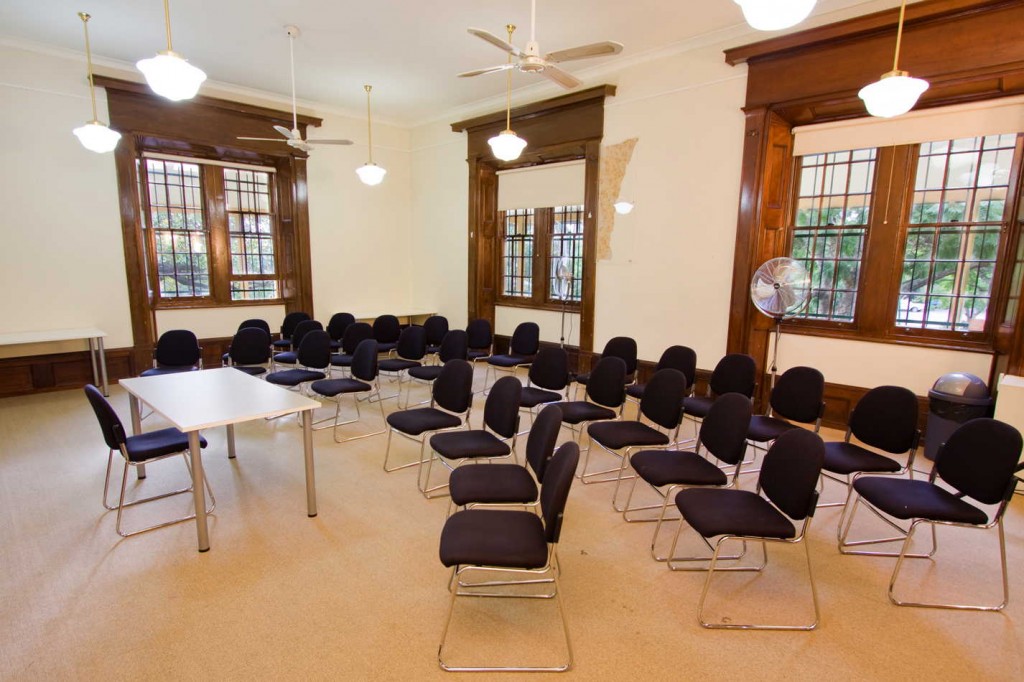Despite his initial reluctance, James Roy is now the author of twenty books for young people, including two Children’s Book Council Honour Books, Captain Mack and Billy Mack’s War, and Town, which won the NSW Premier’s Award (Ethel Turner Prize) in 2008.
Amelia Cox attended the six-week course, Writing for Young Adults with James Roy, run at the NSW Writers’ Centre in November 2014.
Week one
Henry Lawson room
 Cradling my coffee, I settled in and got to know the other students in the class, and our teacher, James Roy. We spoke to each other about who we were, why we were there and what we were working on. It was interesting to hear the backgrounds of the other members of the class and what drew them to Young Adult (YA) writing. Roy mentioned that most YA writers he knows have an itch to scratch about their own childhood or teenage years and this is what drew him to a YA audience.
Cradling my coffee, I settled in and got to know the other students in the class, and our teacher, James Roy. We spoke to each other about who we were, why we were there and what we were working on. It was interesting to hear the backgrounds of the other members of the class and what drew them to Young Adult (YA) writing. Roy mentioned that most YA writers he knows have an itch to scratch about their own childhood or teenage years and this is what drew him to a YA audience.
We talked about structure, plot and pacing, and about how Roy, an author of 30 books, goes about his process of writing. The constructs we use, as writers, to put our characters through hell, developing their personalities and motivations, were earnestly debated. The movie Shrek was given as an example of the outer journey reflecting the inner journey and growth of a character.
We discussed character development, what stories we related to, and how longer and shorter pieces dictated more or less space for subplots. At the end of the day we promised to exchange samples of our own work, to read and give thoughtful critique at later sessions.
Speaking to one of my classmates after the first day, I realised how we all come to this writing gig from different backgrounds, perspectives and at different points within our lives. And I think that’s one thing to appreciate about the act of writing. Everyone has a voice and there is no age or experience limit because we all have a story to tell at each stage of our lives. Agatha Christie wrote from her twenties to her twilight years and there’s no reason the rest of us shouldn’t pick up a pen or laptop whenever we’re ready.
Week two
This week’s class took place outside the Writers’ Centre, under the jacaranda trees near the veranda that wraps itself around the heritage-listed building. It was a perfect day not to be stuck inside the classroom and, with our intimate class size, it didn’t feel as if we were in class at all, but rather a group of like-minded people sharing ideas and concepts about each other’s writing.
During our tea break we chatted about the different stages we were at with our writing and what influenced us. I wanted to learn more about wrangling with a long-form piece. Taming the plot and letting the characters run wild, led by their motivations. How should I keep it all under control?
In response to reading out samples of our work, we focused on the importance of:
- Balancing the technique of showing vs telling the reader the story — how each technique has its place. It’s one thing to write an entire scene in a sentence, but we discussed that often the story will really take off when seen through the character’s eyes, as it’s happening.
- When writing a scene try adding strong imagery, sounds and smells, all through the characters’ eyes. This shows the reader more about your characters, through the way they process the world around them, while advancing the plot — rather than the reader only hearing the narrator or author’s voice.
- We spoke about pace and how it’s important, even in fast-moving action novels, to have space for the reader to breathe and take in more plot. Slower sections are also a good opportunity to unravel cleverly disguised exposition.
Week three
Judith Wright Room
 This week it was my turn to be critiqued and I turned up nervous, because it’s always nerve wracking to get a proper going over of your work by your peers and teacher, but also extremely helpful. I still opted to go last!
This week it was my turn to be critiqued and I turned up nervous, because it’s always nerve wracking to get a proper going over of your work by your peers and teacher, but also extremely helpful. I still opted to go last!
We discussed scenes and what they can achieve, when done right. One powerful example of setting, place and character point-of-view was from a book called True Country, by Kim Scott, an award winning author and Aboriginal man from the Noongar people of Western Australia.
Roy talked about foreshadowing, and how kids sometimes think it’s like magic, when they notice a foreshadowing ‘trick’ a writer has pulled, because they find it hard to think of a novel as anything except being written in a linear progression, when of course, as writers, we learn that editing is where the rewriting, restructuring and plotting comes into effect. (Giving us opportunities to give our young readers delightful little clues as to what’s coming, and seem very clever in the process.)
A few tips:
- How a short line telling us about a character’s background, personality and history can pack a hard punch, when used sparingly.
- The importance of having a strong purpose to each scene, leading the reader on through the plot, as they engage more with the characters. Each character needs a motivation and this is what drives plot and purpose.
- We talked about how small moments, interactions and descriptions of your ‘extras’ or secondary characters within the book can enrich the plot.
When it did get to my turn, although the group were very diligent in their critique of my work, they had some positive things to say as well and I came away from the experience feeling buoyed and ready to tackle the next section of my novel, as well as having a renewed interest in solving some plot problems that had been holding me back.
I got home and wrote six pages that afternoon!
After the break
After our break we presented what we’d reworked and went through the process again, taking into consideration the notes we’d made over the previous three classes. We’d gained each other’s trust by this point and were happy to listen to class suggestions and James’ advice. Over the next three weeks we discussed age-appropriate language, scenes, and techniques to frame difficult content by leaving a lot to the reader’s imagination. We touched on censorship and how libraries are becoming less restrictive, and the importance of not over-moralising in YA fiction.
James took us through different concepts of structure — we discussed how not every story fits the same pre-determined structure, but that it can be a good guide. We checked out Scrivener software, which seems to be a dynamic way to help plan a long piece of work. Although it may not be everyone’s cup of tea, it’s a program that I’m going to trial with my own work.
It was sad to come to the end of such a great course, but the good news is that I’m back to writing regularly again.
If you want to find out more about courses run by the NSW Writers’ Centre, you can find the information here.
Amelia has a Master of Arts in Creative Writing from UTS and a voracious need to experience everything life has to offer. She is also interning at the NSW Writers’ Centre. You can follow her on Twitter, here.

